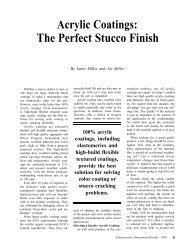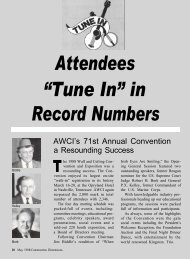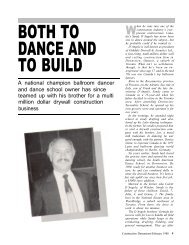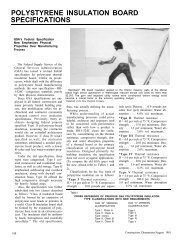What Are the Most Effective New Tools? - AWCI
What Are the Most Effective New Tools? - AWCI
What Are the Most Effective New Tools? - AWCI
You also want an ePaper? Increase the reach of your titles
YUMPU automatically turns print PDFs into web optimized ePapers that Google loves.
<strong>What</strong> <strong>Are</strong> <strong>the</strong> <strong>Most</strong><br />
<strong>Effective</strong> <strong>New</strong> <strong>Tools</strong>?<br />
Contractors and Distributors from Around <strong>the</strong><br />
Country Share Their Opinions of <strong>the</strong> <strong>Tools</strong> and<br />
Equipment They’ve Found Work Best<br />
By Michael J. Major<br />
Where can you find out about <strong>the</strong><br />
hottest new tools on <strong>the</strong> market that<br />
can both increase your productivity<br />
and decrease your costs? One obvious<br />
source is from <strong>the</strong> manufacturers who<br />
make <strong>the</strong>se tools, and Construction<br />
Dimensions magazine, which brings<br />
you ads, notices of new items and newproduct<br />
roundup features. The manufacturers<br />
can best tell you about <strong>the</strong>ir<br />
own products, but <strong>the</strong>y can hardly be<br />
expected to be disinterested observers.<br />
So for this article we’ve taken a different<br />
approach. We’ve randomly called a few<br />
suppliers and several contractors across<br />
<strong>the</strong> country to ask <strong>the</strong>ir opinion. The<br />
suppliers are a step closer to <strong>the</strong> contractors,<br />
and so get direct feedback as to<br />
<strong>the</strong> products <strong>the</strong>y really respond to. But<br />
<strong>the</strong> contractors <strong>the</strong>mselves, of course,<br />
are <strong>the</strong> best sources of what tools really<br />
work best for <strong>the</strong>m. We’ve tried to pin<br />
down <strong>the</strong> respondents in terms of <strong>the</strong>ir<br />
favorite tool’s brand name, manufacturer,<br />
and city and state, and this has<br />
been done in most cases, <strong>the</strong> few exceptions<br />
being when <strong>the</strong> source didn’t have<br />
a particular bit of information at his<br />
fingertips, or when <strong>the</strong> product was relatively<br />
generic. Almost all <strong>the</strong> tools<br />
have been purchased in <strong>the</strong> past year,<br />
except in a very few cases when <strong>the</strong><br />
respondent couldn’t think of anything<br />
special purchased in <strong>the</strong> past year but<br />
had high praise for something purchased<br />
a little beyond that time frame.<br />
A survey like this cannot hope to be<br />
inclusive, and <strong>the</strong>re are no doubts<br />
many fine new products just couldn’t<br />
make it onto this particular list. But <strong>the</strong><br />
following responses, however random,<br />
do have <strong>the</strong> advantage of being au<strong>the</strong>ntic<br />
and unbiased.<br />
So, within <strong>the</strong>se parameters, here are<br />
some of <strong>the</strong> most effective new tools on<br />
<strong>the</strong> market, broken down into <strong>the</strong> categories<br />
of equipment, hand tools and<br />
software.<br />
Equipment<br />
Only three of <strong>the</strong> 20-plus items mentioned<br />
by <strong>the</strong> respondents fit into <strong>the</strong><br />
category of fairly sizable equipment,<br />
but <strong>the</strong>y are all real time-savers.<br />
Electric platform lift: The HEK lift<br />
is <strong>the</strong> favorite new tool of Ron Jefford,<br />
estimator, Horton Drywall, Maumelle,<br />
24 Construction Dimensions r June 1997
Ark. This is a large working platform,<br />
30 feet long, that can be used for ei<strong>the</strong>r<br />
interior or exterior work. Moreover,<br />
two to three can be fastened toge<strong>the</strong>r to<br />
cover a whole side of a building. “It’s<br />
mobile, goes up and down, and since<br />
it’s electric, it’s easy to operate,” Jefford<br />
says. “It’s <strong>the</strong> equivalent of scaffolding<br />
but much more efficient.”<br />
Panel lifter. This panel lifter for drywall,<br />
as described by Bill Schultz, field superintendent,<br />
Jahn & Sons, Inc., Cedarburg,<br />
Wisc., consists of a three-legged<br />
stand, with a mast coming up <strong>the</strong> center,<br />
and <strong>the</strong> top like a TV antenna on top of<br />
which lie <strong>the</strong> drywall. This device cranks<br />
<strong>the</strong> drywall up as high as just under 12<br />
feet and presses it into place so all you<br />
have to do is screw or nail <strong>the</strong> fasteners.<br />
Schultz is not sure of <strong>the</strong> manufacturer<br />
but says this product is available from<br />
most of <strong>the</strong> drywall suppliers. “It’s a great<br />
way to prevent back injuries,” Schultz<br />
says, “for it saves workers from leaning<br />
back to shove <strong>the</strong> panels up in <strong>the</strong> ceiling.<br />
It’s a very swift tool.”<br />
Foam cutter. A real efficient time<br />
saver, also mentioned by Schultz, is <strong>the</strong><br />
foam cutting hot wire machine made<br />
by Wind Lock Corporation, Leesport,<br />
Pa. This device has a hot wire strung<br />
between two sides of a handle, which,<br />
when pulled down, cuts EIFS in an<br />
accurate and convenient manner.<br />
Hand <strong>Tools</strong><br />
There is a variety of hand tools whose<br />
sole purpose is to substitute mechanical<br />
power for muscle power, thus allowing<br />
workers to strain less while producing<br />
more. By far <strong>the</strong> most popular tool we<br />
came across was <strong>the</strong> laser level. There are<br />
many different types, but we stopped<br />
after hearing about <strong>the</strong> first three.<br />
Laser levels. “These are real timesavers,”<br />
says David Hamilton, president<br />
of A. E. Conrad Company, Inc.,<br />
Minneapolis. “They’re used for laying<br />
out partitions or ceilings, and have<br />
turned what was a two-man operation<br />
into a one-man task They shoot out a<br />
beam to 100 years, and instead of<br />
marking just one individual point, it<br />
marks several, so <strong>the</strong>y’re much more<br />
accurate.” Hamilton adds that he utilizes<br />
a number of different brands from<br />
different manufacturers, and that<br />
<strong>the</strong>y’re all basically comparable. Com-<br />
Official Publication of <strong>AWCI</strong> 25
petition among <strong>the</strong> manufacturers<br />
allows him to continually get good<br />
value for bargain prices.<br />
Joe Bolis, shop foreman, Lundquist<br />
Associates, Denver, utilizes his laser levels<br />
for interior walls. He also doesn’t fur<br />
on a particular brand, but says good<br />
ones sell for about $700. “These are<br />
most innovative tools,” he says. “They<br />
shoot three laser beams straight up and<br />
straight out, but can also do a perpendicular.<br />
They’re a lot faster and more<br />
economical than <strong>the</strong> old way of working<br />
with plumb bobs and water levels.”<br />
Bolis says <strong>the</strong>y are handy 2 x 3 inches,<br />
battery operated and used by his company<br />
for grid work and brackets.<br />
Henry St. Hilaire, owner, Central Connecticut<br />
Acoustics, Wallingford,<br />
Conn., has a specific laser level he sticks<br />
with-Minute Marker made by Spectra-physics,<br />
Dayton, Ohio. “The reason<br />
we buy this brand is that it is made<br />
for acoustical ceilings only, and that’s all<br />
we do. The o<strong>the</strong>r lasers may have five or<br />
six different uses, but we have only one<br />
use, so that makes it relatively inexpensive.<br />
The lasers cut down on our labor<br />
by about 10 percent, so a job that<br />
maybe used to cost us $2,000 would<br />
now cost $1,800.” Almost every<br />
mechanic uses one to level ceilings in<br />
large areas, such as shopping centers,<br />
and even small areas.<br />
Sanding sponger. “A simple product,<br />
but one appreciated by contractors, is a<br />
sanding sponger,” reports Susan Holley,<br />
manager, customer service, Building<br />
Materials Wholesale, Birmingham,<br />
Ala. This product, made by 3M, Minneapolis,<br />
is shaped like a sponge, and<br />
has 80 grits on one side and 100 on <strong>the</strong><br />
o<strong>the</strong>r. It’s good, as says Holley, “for getting<br />
up corners.”<br />
Electric sander. “Every time we lend<br />
one out, <strong>the</strong> contractor comes back<br />
and buys it; it’s a very hot seller,” Holley<br />
says, this time referring to <strong>the</strong> electric<br />
sander made by Porter-Cable,<br />
Chicago. “The electric sander works<br />
faster, controls <strong>the</strong> sanding and sucks<br />
up <strong>the</strong> dust,” Holley explains. “Especially<br />
if you’re doing remodeling work<br />
where <strong>the</strong>re’s furniture or equipment<br />
around, you don’t want dust flying<br />
everywhere.”<br />
26 Construction Dimensions r June 1997
This praise is seconded by ano<strong>the</strong>r<br />
wholesaler, Lee Ballard, store manager,<br />
Capital Building Supply, Vienna, Va.,<br />
who offers <strong>the</strong> Porter-Cable model<br />
numbers 7810 and 7899. “Everybody<br />
has problems with dust, especially <strong>the</strong><br />
pollution/health aspect. But <strong>the</strong> rotaing<br />
sanders on this tool simply suck <strong>the</strong><br />
dust up through <strong>the</strong> vacuum.”<br />
Drywall cutter. A Potter-Cable power<br />
tool, model 7499, that Fahrer also finds<br />
valuable is <strong>the</strong> wallboard cutter that<br />
replaces <strong>the</strong> hand keyhole saw for cutting<br />
cut small holes in drywall. “The<br />
workers seems to like it, especially in<br />
view of <strong>the</strong> fact that it has special fitting<br />
that keep <strong>the</strong> dust from getting<br />
into <strong>the</strong> motor,” he says.<br />
Autofeed screw guns. Ballard also<br />
has good words to say about Makita's<br />
autofeed screw gun, which holds 50<br />
screws at a time. “It’s fast, easy to use,<br />
durable, requires low maintenance and<br />
makes <strong>the</strong> job go at least 25 to 30 percent<br />
faster,” he says.<br />
Elwood Stanton, warehouse manager,<br />
Capital Interior Contractors, Inc.,<br />
Richmond, Va., reports that Black &<br />
Decker’s screw gun, model 2125, “has a<br />
durability much greater than what<br />
we’ve used in <strong>the</strong> past. We’re a drywall<br />
contractor involved with interior and<br />
exterior framing, and have never found<br />
a gun with enough torque to attach <strong>the</strong><br />
heavier studs. This gun has that feature,<br />
and is durable enough so we don’t have<br />
to use a separate gun.<br />
Also happy with <strong>the</strong> Potter-Cable screw<br />
guns are <strong>the</strong> workers at Interior Systems,<br />
Inc., Boise, Idaho. But, as explains<br />
risk manager, John Fahrer, <strong>the</strong> merging<br />
of Black & Decker with DeWalt means<br />
replacing <strong>the</strong> former models with <strong>the</strong><br />
latter. Fahrer says, “It takes a while for<br />
workers to get used to something new<br />
and feel good about it,” but adds that<br />
<strong>the</strong> increased power of DeWalt’s new<br />
guns, moving from 12-14.4 volts to 18<br />
volts and a 5.4 to 6.2 amp motor, is<br />
making for a more powerful tool that is<br />
accelerating <strong>the</strong> acceptance process.<br />
Countertop trimmer. Fahrer also has<br />
praise for <strong>the</strong> Porter-Cable model 7319<br />
tool used for trimming countertop laminate.<br />
“The higher amp motor in this<br />
tool, 5.4 as opposed to 3.8, costs a little<br />
more money, but works well for heavyduty<br />
countertop trimming and is adaptable<br />
to cutting out windows and doors.”<br />
Gas-operated fastening tool.<br />
Attach this tool, Trackfast, made by<br />
ITW Ramset, Wood Dale, Ill, to <strong>the</strong><br />
top of bottom track of concrete or steel,<br />
and you have a fastener that, says Jeff<br />
Mirgon, operations manager for Compass<br />
Construction, Inc., Amlin, Ohio,<br />
“is speedy, efficient, easy to use, safe<br />
and not exceptionally noisy.”<br />
Ceiling tile cutter. As opposed to <strong>the</strong><br />
manual method of cutting tiles, this<br />
tool, called Tegrat, made by Vinal Industries,<br />
Ipswich, Mass., electronically measures,<br />
cuts or lays tiles in 10 seconds or<br />
less,” reports Anebel Hernandez, vice<br />
president, sales, All-Interior Supply, Inc.,<br />
Hialeah, Fla. It costs $900 and provides<br />
perimeter or lining cuts in <strong>the</strong> field.<br />
Cordless saw. This cordless power saw<br />
has found favor with contractors, says<br />
Hill Grant, branch manager, Kel-Welco<br />
Distributing, Inc. Omaha, Neb. Grant<br />
says that this tool, made by <strong>the</strong> Milwaukee<br />
Power-Tool Company, Brookfield,<br />
Wisc., is an all-purpose reciprocating<br />
saw that weighs only 8.25 pounds but is
powerful, with an 18-volt battery system,<br />
a 1-inch blade stroke. The saw also<br />
works at variable speeds.<br />
Software<br />
Just as power tools are designed to save<br />
<strong>the</strong> muscular effort of field workers, so<br />
too does software aim to save <strong>the</strong> mental<br />
effort of office workers, at <strong>the</strong> same time,<br />
of course, of increasing productivity<br />
When you consider that just a few years<br />
ago <strong>the</strong>re were no software tools, it<br />
seems a bit odd that now <strong>the</strong>re are many<br />
more kinds of software tools over <strong>the</strong><br />
actual physical tools that get <strong>the</strong> jobs<br />
done. Here are a few samplings:<br />
Tool inventory and management system.<br />
Grant explains that ToolWatch,<br />
made by ToolWatch Corporation, Engelwood,<br />
Colo., enables <strong>the</strong> contractor<br />
to gain control of his tool inventory, reducing<br />
losses of lost and misplaced tools<br />
while at <strong>the</strong> same time increasing productivity.<br />
<strong>Tools</strong> are given a number and<br />
a bar code label, with that information<br />
recorded on <strong>the</strong> software, which tracks<br />
<strong>the</strong> tools as <strong>the</strong>y move from job to job.<br />
Tool tracker. This is basically <strong>the</strong> same<br />
sort of system, though called Tool Tracker,<br />
and made by Waterwheel, Inc. Rick<br />
Voorhorst, warehouse manager, The<br />
Bouma Corporation, Grand Rapids,<br />
Mich., says this system “is worth its<br />
weight in gold. Before we never knew<br />
where our tools were, for people were<br />
always moving on and off jobs. Now we<br />
always know. All of <strong>the</strong> tools are numbered<br />
and is issued to particular jobs and<br />
so are continually tracked. Also, <strong>the</strong> system<br />
enables us to bid tool costs into a<br />
job.”<br />
Design software for steel frame<br />
trusses. Mark Nabity, president, Gray-
hawk, LLC, Lexington, Ky., explains<br />
that Mitek, in St. Louis, Mo., has long<br />
been a leader in providing software for<br />
wood trusses, but has just recently come<br />
out with a comparable product for steel<br />
trusses, with apparently only one o<strong>the</strong>r<br />
company also having come out with a<br />
similar product.<br />
“This software helps us to do shop drawings<br />
and layout and engineering of light<br />
gauge steel Frame trusses,” Nabity says.<br />
“Up to now it had been very slow to get<br />
<strong>the</strong> information we’ve needed, and we’ve<br />
had to bring in an engineer and pay hi<br />
just to be able to bid a project. It’s expensive<br />
and time-consuming.”<br />
<strong>What</strong> we were finding is that we had<br />
plenty of opportunity to use metal trusses,<br />
but we were not able to respond in<br />
a timely continued on page 66
<strong>Tools</strong>, continued from page 29<br />
or economic fashion because of <strong>the</strong> design issues. But now we<br />
can, so this software is very valuable for us.”<br />
Estimating software. “The estimating package has really<br />
helped our guys do a better job and cover a bigger area,” says<br />
Bill Lint, purchasing agent, Allied Construction Services, Inc.,<br />
Omaha, Neb. The software Lint is speaking of is Quick Bid,<br />
made by On Center Software, Houston. “This package details<br />
just how each estimator estimates each job,” Lint says. “Before,<br />
each estimator had his own way of doing it, and <strong>the</strong> production<br />
department might not always know just what he had in<br />
mind. This software requires a standardized procedure <strong>the</strong><br />
same for every estimator.” Lint adds that this software also<br />
provides an excellent stocking list and helps him, as purchasing<br />
agent, to order <strong>the</strong> right material in timely fashion.<br />
Also enthusiastic about his choice of estimating software is B.<br />
J. Sutcliffe, president of Acousti of Columbus, Inc., Columbus,<br />
Ga. Sutcliffe uses software from Timberline, of Beverton,<br />
Ore. “Just by plugging in <strong>the</strong> length and width of material, it’s<br />
been an incredible time-saver, but it also provides a detailed<br />
labor and material breakdown,” Sutcliffe says.<br />
Sutcliffe says he looked around a lot and talked with many<br />
general contractors and subcontractors, and Timberline was<br />
recommended most often. “From doing our estimating by<br />
hand to using this software we’ve probably cut down our estimating<br />
time down by 50 percent, allowing us to do more with<br />
project management. We’re a fairly small company, with just a<br />
few of us in <strong>the</strong> office, so <strong>the</strong> time we would have spent doing<br />
estimating we can now spend in <strong>the</strong> field, doing project management<br />
and making more money.”<br />
Estimating/networking software. Getting good estimating<br />
software is one thing, but <strong>the</strong> next is <strong>the</strong> coordination of this<br />
estimating through computer networking, and this is what<br />
Vernon Boyett, president, Boyett Construction, Inc., South<br />
66 Construction Dimensions r June 1997
San Francisco, is most involved in currently.<br />
Utilizing Microsoft’s Windows 97, all<br />
estimators know what is being bid by<br />
each o<strong>the</strong>r. The network is set up with<br />
<strong>the</strong> job name, number, how many<br />
hours in each area, and <strong>the</strong> labor in<br />
each area. “When we’ve made a successful<br />
bid, <strong>the</strong> information immediately<br />
pops up on <strong>the</strong> screen in <strong>the</strong> construction<br />
manager’s office, so he knows<br />
he has a job immediately and can begin<br />
preparing, ra<strong>the</strong>r than wait for a week<br />
until <strong>the</strong> paper work gets <strong>the</strong>re. It’s an<br />
early warning system for him, and<br />
enables him to communicate with <strong>the</strong><br />
estimators ra<strong>the</strong>r than wait for <strong>the</strong> estimator<br />
to come to him.”<br />
Integrated software. Software is not<br />
just a single tool. It’s a multiplicity of<br />
tools that work best when integrated.<br />
For instance, Curtis W. Braun, president,<br />
Braun Plastering Co., Inc., Jefferson<br />
City, MO., utilizes a 36 x 48 inch<br />
digitizer board offered by <strong>the</strong> Clearwater,<br />
Fla.-based Dewitt, which allows<br />
him to take off different materials off<br />
<strong>the</strong> blueprints and add overhead and<br />
equipment costs to determine a profit.<br />
He’s also recently acquired a laptop<br />
computer for jobsite or quick-change<br />
orders, utilizes e-mail for job meetings,<br />
and CD-ROM for government jobs.<br />
“With <strong>the</strong> economy booming, you’re<br />
expected to do so much more in <strong>the</strong><br />
same amount of time,” Braun says,<br />
“And you can’t do it with pencils,<br />
notepads and a couple of calculators.”<br />
About <strong>the</strong> Author<br />
Michael J. Major, of Anacortes, Wash.,<br />
is a free-lance writer for <strong>the</strong> construction<br />
industry,

















